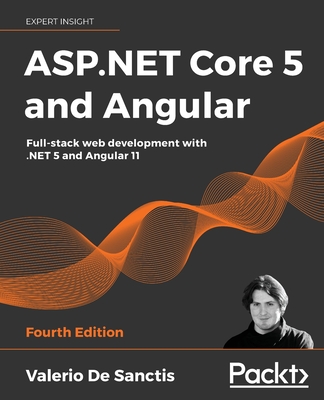Building Microservices with .NET Core 2.0 - Second Edition
暫譯: 使用 .NET Core 2.0 建立微服務 - 第二版
Gaurav Aroraa
- 出版商: Packt Publishing
- 出版日期: 2017-12-22
- 售價: $1,810
- 貴賓價: 9.5 折 $1,720
- 語言: 英文
- 頁數: 300
- 裝訂: Paperback
- ISBN: 1788393333
- ISBN-13: 9781788393331
-
相關分類:
.NET、Microservices 微服務、SOA
-
其他版本:
Hands-On Microservices with C# 8 and .NET Core 3, 3/e (Paperback)
買這商品的人也買了...
-
 C# 7 and .NET Core 2.0 Blueprints
C# 7 and .NET Core 2.0 Blueprints$1,990$1,891 -
 單元測試的藝術, 2/e (The Art of Unit Testing: with examples in C#, 2/e)
單元測試的藝術, 2/e (The Art of Unit Testing: with examples in C#, 2/e)$650$507 -
 一步到位!RWD 網頁程式設計 - 用 HTML5、CSS3、Bootstrap 打造響應式網頁
一步到位!RWD 網頁程式設計 - 用 HTML5、CSS3、Bootstrap 打造響應式網頁$480$408 -
 $990Dependency Injection in .NET Core 2.0: Make use of constructors, parameters, setters, and interface injection to write reusable and loosely-coupled code
$990Dependency Injection in .NET Core 2.0: Make use of constructors, parameters, setters, and interface injection to write reusable and loosely-coupled code -
 MIS 一定要懂的 82個網路技術知識
MIS 一定要懂的 82個網路技術知識$360$284 -
 無瑕的程式碼-整潔的軟體設計與架構篇 (Clean Architecture: A Craftsman's Guide to Software Structure and Design)
無瑕的程式碼-整潔的軟體設計與架構篇 (Clean Architecture: A Craftsman's Guide to Software Structure and Design)$580$452 -
 最漂亮動感的前端框架:Bootstrap 讓你的網站與眾不同
最漂亮動感的前端框架:Bootstrap 讓你的網站與眾不同$580$493 -
 圖解 AI 人工智慧大未來:關於人工智慧一定要懂得 96 件事
圖解 AI 人工智慧大未來:關於人工智慧一定要懂得 96 件事$380$323 -
 $232微服務實踐
$232微服務實踐 -
 Fundamentals of Software Architecture: A Comprehensive Guide to Patterns, Characteristics, and Best Practices (Paperback)
Fundamentals of Software Architecture: A Comprehensive Guide to Patterns, Characteristics, and Best Practices (Paperback)$2,690$2,556 -
 程式設計師從零開始邁向架構師之路
程式設計師從零開始邁向架構師之路$650$514 -
 量子霸權(Quantum Supermacy)世界大戰開打:量子電腦真的來了
量子霸權(Quantum Supermacy)世界大戰開打:量子電腦真的來了$600$474 -
 AI 背後的暗知識:機器如何學習、認知與改造我們的未來世界
AI 背後的暗知識:機器如何學習、認知與改造我們的未來世界$420$357 -
 人類智慧的神殿:AI 知識圖譜實作
人類智慧的神殿:AI 知識圖譜實作$890$703 -
 橫跨 Android 及 Apple 的神話:用 Dart 語言神啟 Flutter 大業
橫跨 Android 及 Apple 的神話:用 Dart 語言神啟 Flutter 大業$690$545 -
 前端三雄首強:用 Angular 高速聰明開發多介面
前端三雄首強:用 Angular 高速聰明開發多介面$680$537 -
 NLP 工程師養成術:自然語言處理入門
NLP 工程師養成術:自然語言處理入門$690$538 -
 猜心競賽 : 從實作了解推薦系統演算法
猜心競賽 : 從實作了解推薦系統演算法$780$616 -
 下世代超前佈署:用 Zabbix 全面監管巨量伺服器
下世代超前佈署:用 Zabbix 全面監管巨量伺服器$880$695 -
 AI 語音辨識:用 Kaldi 實作應用全集
AI 語音辨識:用 Kaldi 實作應用全集$880$399 -
 小輕快跨平台:王的編輯器 Visual Studio Code 聖經
小輕快跨平台:王的編輯器 Visual Studio Code 聖經$880$695 -
 還在 LAMP?用最流行的 MEAN 進行全端網頁開發
還在 LAMP?用最流行的 MEAN 進行全端網頁開發$780$616 -
 用 Node.js 一統 JavaScript 前後端:強勢 Web 開發親手作 (有些許瑕疵,不影響閱讀)
用 Node.js 一統 JavaScript 前後端:強勢 Web 開發親手作 (有些許瑕疵,不影響閱讀)$780$616 -
 最新 AI 技術:知識圖譜集技術概念大成
最新 AI 技術:知識圖譜集技術概念大成$980$774 -
 編寫程式的邏輯:如何用物件導向實作複雜的業務需求
編寫程式的邏輯:如何用物件導向實作複雜的業務需求$680$530
相關主題
商品描述
Key Features
- Start your microservices journey and understand a broader perspective of microservices development
- Get started with .NET Core 2.0 for microservices
- Build, deploy, and test microservices using ASP.Net Core, ASP.NET Core API, and Microsoft Azure Cloud
Book Description
Microservices is an architectural style that promotes the development of complex applications as a suite of small services based on business capabilities. This book will help you identify the appropriate service boundaries within the business. We'll start by looking at what microservices are and what the main characteristics are.
Moving forward, you will be introduced to real-life application scenarios, and after assessing the current issues, we will begin the journey of transforming this application by splitting it into a suite of microservices. You will identify the service boundaries, split the application into multiple microservices, and define the service contracts. You will find out how to configure, deploy, and monitor microservices, and configure scaling to allow the application to quickly adapt to increased demand in the future.
With an introduction to the reactive microservices, you strategically gain further value to keep your code base simple, focusing on what is more important rather than on the messy asynchronous calls.
What you will learn
- Get acquainted with Microsoft Azure Service Fabric
- Compare microservices with monolithic applications and SOA
- Define the service interface and implement the APIs using ASP.NET Web API
- Integrate the services using a synchronous approach via RESTful APIs using ASP.NETCore
- Implement microservices security using Azure Active Directory, OpenID Connect, and OAuth 2.0
- Understand the operations and scaling of microservices in .NET Core
- Understand the testing pyramid and implement consumer-driven contracts using pact net core
- Understand what the key features of reactive microservices are and implement them using reactive extensions
商品描述(中文翻譯)
關鍵特點
- 開始您的微服務之旅,並了解微服務開發的更廣泛視角
- 使用 .NET Core 2.0 開始微服務的開發
- 使用 ASP.Net Core、ASP.NET Core API 和 Microsoft Azure Cloud 建立、部署和測試微服務
書籍描述
微服務是一種架構風格,促進將複雜應用程式開發為一組基於業務能力的小型服務。本書將幫助您識別業務中的適當服務邊界。我們將首先了解微服務是什麼以及其主要特徵。
接下來,您將接觸到實際應用場景,並在評估當前問題後,我們將開始將此應用程式轉型為一組微服務的旅程。您將識別服務邊界,將應用程式拆分為多個微服務,並定義服務合約。您將學習如何配置、部署和監控微服務,並配置擴展以使應用程式能夠快速適應未來的需求增加。
通過介紹反應式微服務,您將戰略性地獲得進一步的價值,以保持您的代碼庫簡單,專注於更重要的事物,而不是混亂的非同步調用。
您將學到的內容
- 熟悉 Microsoft Azure Service Fabric
- 將微服務與單體應用程式和 SOA 進行比較
- 定義服務介面並使用 ASP.NET Web API 實現 API
- 通過使用 ASP.NET Core 的 RESTful API 以同步方式整合服務
- 使用 Azure Active Directory、OpenID Connect 和 OAuth 2.0 實現微服務安全性
- 理解 .NET Core 中微服務的操作和擴展
- 理解測試金字塔並使用 pact net core 實現消費者驅動的合約
- 理解反應式微服務的關鍵特徵並使用反應式擴展實現它們






























